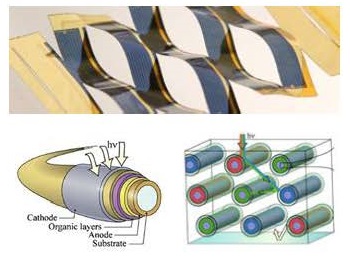ChEMS Seminar: Multi-Scale, Flexible and Dynamic Fiber and Kirigami Structures for Solar Energy Conversion

Abstract: Conventional electronic devices are usually flat and rigid, in large part because they are made from crystalline semiconductors using well-established, wafer-based processing methods. Many new applications and materials, however, compel us to think about non-planar device structures and new processes for realizing them. In this talk we will consider fiber [1] and kirigami [2] based solar cells capable of increasing solar energy conversion efficiency over their conventional, flat analogs. For fiber-based devices, we will consider performance as a function of device geometry and material selection, extending the concept to novel reflective tandems [3]. In the case of kirigami solar cells, we will discuss how dynamic solar tracking is accomplished by a 2D-to-3D transformation, involving engineered stress-strain behavior of a mechanical metamaterial. The dynamic loading of the metamaterial results in controlled, uniform buckling and can be used to increase energy output throughout the day. The trade-offs between economy of semiconductor material and module area will be discussed, as well as other advanced configurations that can drive down the cost of semiconductor used in a PV module by a factor of 10 or more.

Biography: Professor Shtein earned his B.S. in chemical engineering at UC Berkeley (1998) and Ph.D. in chemical engineering while working in an Electrical Engineering lab of Stephen Forrest at Princeton University (Summer 2004), where he developed Organic Vapor Phase Deposition and Organic Vapor Jet Printing techniques. He joined the Department of Materials Science and Engineering at the University of Michigan in Fall 2004, where he now serves as associate professor of MSE, with courtesy appointments in chemical engineering, applied physics, macromolecular science and engineering, and art & design. He recently started serving as faculty co-director for the undergraduate program in entrepreneurship. His work has been recognized through several awards, including the Presidential Early Career Award for Scientists and Engineers (PECASE) from the Air Force Office of Scientific Research, the MSE Department Achievement Award, College of Engineering-wide Vulcans Prize for Excellence in Education, the Holt Award for Excellence in Teaching, the Newport Award for Excellence and Leadership in Photonics and Optoelectronics, and the Materials Research Society (MRS) graduate student Gold Medal Award. He recently co-founded Arborlight, LLC (www.arborlight.com – a lighting technology company), and co-authored the book “Scalable Innovation: A Guide for Inventors, Entrepreneurs, and IP Professionals.” (Taylor & Francis, ISBN-10: 1466590971)
Share
Upcoming Events
-
MAE 298 SEMINAR: Technology Developments for FIR Bolometric Detector Focal Plane Assemblies
-
CBE 298 Seminar: The Wisdom of the Crowd: Watching Bacterial Collectives (Re)shape Themselves
-
CEE Seminar: BIM and the Digital Twin
-
MSE Special Seminar: Revolutionizing Battery Technology - Engineering Quantum Materials for Enhanced Safety and Performance in Solid Electrolytes
-
MSE Special Seminar: Designing Sustainable Soft Matter from the Molecule Up
